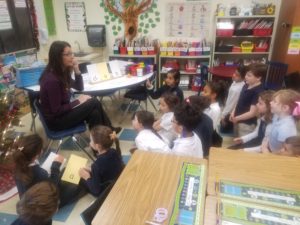
Bridget Cassidy with some of her star pupils as they show off their growing skills.
At the independent Ranney School in Tinton Falls, New Jersey, Cassidy began working with seven new students in fall 2017 who were struggling with reading.
“They came to me with a variety of challenges. They didn’t have all of their letter sounds,” Cassidy said. “We started at the very beginning with OG. We did the three‐part drill, and we did everything in our power to move forward.”
Cassidy worked with the students five days a week, for at least an hour each day. She prepared IMSE’s Orton‐Gillingham lessons, focusing on individual letters and red words. Tapping became a favorite activity.
The kids initially tested at Level B on Fountas and Pinnell. Within a year, they’d all jumped to Level G — displaying a one and a half year gain in a year’s time. Level A on Fountas and Pinnell is beginning Kindergarten; level G is the middle of first grade.
A sample of students’ NWEA assessment scores also showed steady growth, with the children “approaching expectation” levels for literacy.
“They’ve had the opportunity to grow in many different ways,” Cassidy said. “Do they still have to work at it? Of course they do. … But just the fact that they’re willing to pick up a book and do something — because they were really reluctant at first — is a big deal.”
Ranney School sits on a 60‐acre campus in New Jersey’s Monmouth County, a coastal county in the center of the state. There are roughly 600 students from 3 years old through 12th grade, including international students from China and elsewhere.
Kerri Bahr’s daughter Sadie transferred to Ranney at the beginning of the 2017‐2018 school year for the start of first grade. Sadie, now 8, was recently diagnosed with a reading disorder impacted by ADHD and wasn’t reading at grade level.
“My daughter struggled terribly with reading,” Bahr said. “Her understanding, her comprehension, her fluency — all of that was way behind.”
Sadie is one of the seven first graders Cassidy worked with daily last school year, using IMSE’s approach. Sadie has made incredible strides with her reading rate and ability to decode words. She hopes to tackle the Junie B. Jones series in the near future.
“Bridget has really helped her become more fluent,” Bahr said. “She’s made her feel more confident about reading. She’s made her feel more confident about words. … If there’s a book fair or a Scholastic order, she picks out the chapter books that she’s not ready for. … I know that she wants to be at that level.”
Part of Sadie’s success, Cassidy said, is that all Lower School teachers have been trained in IMSE’s Orton‐Gillingham. The lessons Sadie learns with Cassidy in small sessions continue into the classroom.
Initially, Ranney School administrator Dr. Andrea Danial committed to all classroom teachers receiving training in IMSE’s Orton‐Gillingham as a preventative measure for any student who may be at risk in developing phonemic awareness and phonics skills. This step ensures that all students develop these foundational skills for the purposes of reading and eventually spelling, allowing for additional guidance and instruction from the reading specialist.
“I saw how well it worked for some of the students,” Cassidy said. “We were all going to learn.”
Now, teachers for beginners (age 3) through fifth grade use IMSE’s Orton‐Gillingham. In addition to working individually and in small groups with struggling readers, Cassidy helps classroom teachers set up a reading curriculum and create spelling lists that support reading and writing.

First-grade teacher JoAnn Petrantis works with children at Ranney School.
Teachers said they appreciate that IMSE’s Orton‐Gillingham approach isn’t about rote memorization. There are specific reasons to use each technique — and that makes sense to both students and parents looking to provide extra help at home.
“I use [IMSE’s Orton‐Gillingham] every day in my classroom to reinforce spelling skills and reading skills,” first‐grade teacher JoAnn Petrantis said. “My class loves it. They fully embrace it — the tapping out, the red words. It’s made a huge difference in the abilities of all students.”
Petrantis said her students aren’t allowed to ask for spelling help until they’ve tried tapping out a word.
“We’re trying to challenge them a little bit more with their writing skills,” she said. “…The kids can take this philosophy and techniques and continue applying them for the rest of their lives. They’re a very useful tool.”
Ranney School has been pleased with the success of the students’ learning, prompting the support of Cassidy beginning training to become an instructor for IMSE. In that capacity, Cassidy will travel to other schools to help teachers implement IMSE’s Orton‐Gillingham techniques in their classrooms during both summer months and her off‐time during the school year, while continuing her supportive role as literacy coach at Ranney Lower School.
“I am so passionate about this program,” Cassidy said. “I know it works. I want other people to realize that we can help so many more kids. It needs to get in the hands of everybody.”
—
IMSE believes that all children should be able to read. To achieve this end, IMSE wants to bring Orton-Gillingham to all educators to give children the best literacy instruction possible.
Learn more about what you can do to improve literacy for all using the Institute for Multi-Sensory Education’s Orton-Gillingham training.
Please connect with us on Facebook, Twitter, and Pinterest to get tips and tricks from your peers and us. Read the IMSE Journal to hear success stories from other schools and districts, and be sure to read the OG Weekly email series for refreshers and tips.
